Shaolin 1998
Tales from last year, 1998...
It's Monday (I'm leaving out a lot of the capital letters, because, basically, I'm pooped, and I don't feel like hitting that shift key way over there) here, and winter just arrived this afternoon, much like it did last year, at about almost the same time. Yesterday's sunshine and warmth turned to overcast polluted skies, and one hell of a chilly breeze. It's tough working out almost outside (I'm in the entrance lobby of the wushu guan, as the germans are learning tai chi in the main training room, and the polish are learning the basics in the main demonstration room). (Funny, they don't talk to each other) The germans talk to me, in german (I just shake my head), as their tour leader, a man whose name I can't remember, or pronounce if I did, was here last year at this time. We're regulars. The poles only talked to me long enough to find out what I knew. Once I went with my master to another area to train, they kind of excommunicated me. A few spoke english, but they probably didn't like the fact that I wasn't going through the basics with them. I guess it's an ego thing. If they only knew what training I went through today compared to what they had...
Yesterday was a bright sunny day, as only china can present. I required sunglasses, but the haze and pollution and god knows what else up there opacifies the sun made the light its usual soft quality. The requisite climb up the mountain was done, in an attempt to strengthen the legs. Today, training began. I started at 0730, as I usually try to do, doing all the running and stretching and basic maneuvers and forms on my own, before formal training starts at 9. We finish at 11, which doesn't seem to come soon enough, after which a "passing out on the way too small bed" is in order. I started again at 1 on my own, and had more formal training for what was supposed to be two hours at 3.
I only made it to 4. I guess I'm getting old. Master understood.
Master (not my real master, I'm just using this one as mine is in Austria, and is supposed to return here in November) is 25 years old. He's been here for fifteen years, just learning and practicing gung fu at the temple. "Damn good" doesn't do him justice. ("Pitiful" fits me just right). As I've been here before, we basically reviewed almost all of the basics, and one of the four forms that I know, and then headed off into not the usual waters.
When the monks teach the foreigners, they teach the basics and some basic forms (katas in our lingo), without getting too far into what it all means. Call it secrecy, call it "having to be a member of the club", the foreigners just don't get it all. They're shown some moves and expected to perform them, without really knowing how you use them to kill people. Last year I became a member of the club, and I started to learn the applications to these things. Today, we practiced them, not full contact, but with some contact. It was interesting to hit a monk. They're pretty hard, they're bones seem like rocks, and when you hit one of them, or get hit by one, you know it. Then again, the monks haven't seen legs like mine, so whenever master was going to get kicked, master just got out of the way. I avoided his arms, he avoided my legs. It's kind of perfect. In any event, training was hard today, and I'm pretty sore.
He is pretty patient, as I find that despite proper breathing and frequent small rest periods, I still get that damn head pressure. I didn't get it much the last time I was here, as the usual migraine triggers don't really exist here in large quantities, but today was just not good. My usual medication is just not holding me; I've had to retreat to a bunch of aspirin and Advil to keep it within tolerable limits. the head does keep my mind off of the legs, which are not exactly too happy either. Despite the pain, it was a good training day.
I am very, very fortunate in one respect. Yes, it is still the same place as last year, with a few exceptions. A little cleaner, more cleaner "restaurants", some monetary inflation (bottled water now costs 3 Yuan instead of 2, a Yuan being around 13 cents), the same run down rooms, but this year, two very major differences. I know have running water all day, and, last night, for the first time in all the time I've ever been here, I had a really hot shower. The "hotel" turns on the water when there are large groups here, and even puts out some hot water at 8PM for a brief time. Because of the germans and the poles, I can wash in water that is not cold. It has made all the difference in the world. Now if I can only get that karaoke place in the valley to tone it down (they must have gotten new amplifiers this year), maybe I can get some sleep.
A favorite restaurant
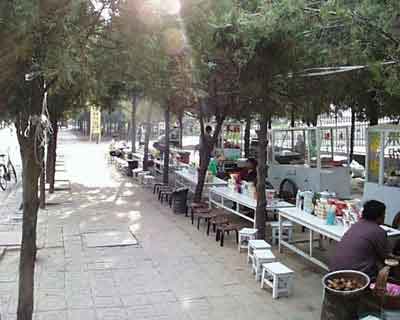
A favorite outdoor restaurant
Economically, the changes in this little village are fairly large, and noticeable to me, having started coming here four years ago. People have more money, they dress better, and now instead of getting around mainly on bicycles, now have scooters and small motorcycles. The streets are clean (no more rats constantly running around, though I did see one briefly yesterday), the "shops" are better equipped, and the "restaurants" are actually improving, at least visually. I haven't been too tempted to try the food (even though I know have a flushing toilet, and no longer have to hunt down water to flush it), I don't want to push it. My sustenance has largely been protein packs that I have brought from home, with some mandarins, and the requisite "street cooked" lamb, so perfectly prepared by the Muslim who slaughters a lamb once a week or so.
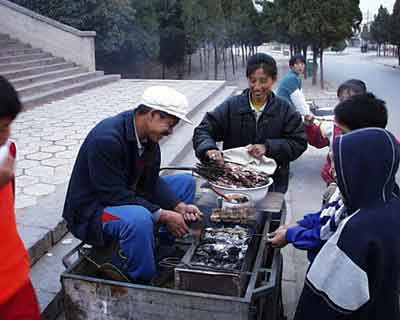
The Lambmaster
So far so good. I really don't know if I can jury rig the phone system in this room yet, nor do I know if I can access the net in Beijing from here. Once I get that down, I'll be able to get more out.
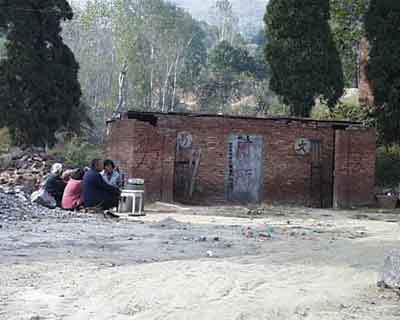
The "consequences" of not finding water to flush your toilet....
Tales from the past: Meeting the Four Tops. 1998
It's Monday night, and I've had a very tiring past few days. It's back to the ways of the old days, when hot water didn't exist, and cold water ran infrequently. It happens because they don't bother heating water unless there is a large group of people here. There isn't a large group of people here, actually, it is only me here. There is no one else in the entire "hotel". And from what I can see, I am the only foreigner left in the village. People don't come to train here in the winter as it gets too cold. I did happen to meet a guy from New Jersey on Saturday afternoon, a budding photojournalist, who was in some other part of China taking pictures of the Chinese cave dwellers, but happened to find himself "evicted" from the province when he was caught taking pictures of police beating the hell out of some poor civilian. We were supposed to get together for dinner that night. I haven't seen him since.
I had thought that I was going to have the honor of meeting some of the Temple's greatest, the Four Tops (the only four remaining monks at the Temple that survived the Cultural Revolution in the 70's) on Sunday, but since that didn't happen, I spent the day on the Chinese Stairmaster again. Seven hours, including frequent rest stops, up and down and up and down, for what seemed an eternity. The weather was a bit better than the last time, which definitely changed the appearance of the place. It is really, incredibly beautiful. I considered it one of my last opportunities for final conditioning before risking the altitude in Tibet, which occurs in a few days.
I was trying to finish this when the phone rang. It was Wang lun ( I call her white cloud, that's what it means, and I keep on forgetting wang lun, and one of her friends). I got hijacked to the karaoke bar down the hall, that dreaded place that has the usual one drunk Chinese guy singing every damn night until around 1100PM. I have long learned that it is a real slap in the face if you turn down an invitation of any sorts in this country. The Chinese just don't understand "no". They don't even understand "fuck off". I still don't get it, so instead of hurting their feelings, I went and had a bottle of water, and listened to terribly loud music. Now Chinese karaoke is an interesting phenomena. Let me explain. As you probably know, there is some degree of infanticide here in this country, and it predominantly involves the killing or abandoning of baby daughters. True, Chinese families can only have one child, and in the rural areas, two sometimes are allowed. If you live in a city and want two, you can pay a lot of money, something like six thousand dollars, and you can have a second. Now traditionally, as the parents get older, they tend to not end up in a nursing home as we do in the US, they end up in the son's house. Sons also are useful as they can tend the fields, build houses, do useful things. Daughters, on the other hand, are fairly useless to a family, as after they are married and gone, those parents have nowhere to go when they get older. Daughters are not as strong as sons, and therefore are not as desirable to tend the fields. Therefore, when one looks at the entire country, there is a relative dearth of females. Men looking to marry have a difficult time finding a wife sometimes, because the ratio of men to women is off a bit. Now that you are expert with Chinese demographics, a look at Chinese karaoke.
If you think a screaming Chinese baby is obnoxious, try one when he gets older and a bit more drunker. And then make the terrible mistake of giving him a microphone. Chinese karaoke is all basically the same formula. Boy longs for a girl, boy dreams of girl, boy meets girl, girl (who on these videos is usually very beautiful; I wonder where they find them....) pretends to fall in love with boy, boy falls in love with girl, girl disappears. The Chinese movies are all the same shit too. No wonder they all want to learn gong fu and beat the shit out of each other.
After a long work out this morning, I finally received my invitation to meet the Four Tops. I was to be at the Shaolin Temple at 2 PM; I brought both cameras. But first, a little history. Back in the late 60's, during the Cultural Revolution, students and the such were pushed to rebellion against the intelligentsia and religious figures of society, kind of like Hitler's henchmen going after the Jews and professionals of that time. As opposed to Chairman Mao's previous successful societal movements in the 50's, known as the "Great Leap Forward", when he brought the country together, his Cultural Revolution, whereby he tried to make everyone equal by pushing the professional and technical people into farming positions, and tried to destroy representations of religious life, became to be known as the "Great Leap Backward". Well, the Shaolin Temple was no stranger to all of this nonsense, and in the late '60s, it too suffered from this mayhem. Of the hundred of so monks here at the time, all but thirteen left for good. Some hid in the mountains, some hid in some buildings in the back of the Temple, and most left the monkhood to return to their home towns, marry, and pretend to me non-monks, a much safer profession at the time. (That is where the category of "custom monk" came about, a monk (disciple) of the Shaolin Temple, but able to marry, and not live at the Temple). Some monks returned, in all, only 13 were left when the government decided that the Cultural Revolution was bad policy, after Mao's death in I think '76.
These 13 monks carried on the tradition of the Shaolin Temple, passing on some 1480 years of gong fu traditions to a new younger generation of Shaolin Temple monk. Interestingly enough, the movie "Shaolin Temple", from I think 1982, which starred some gong fu actors from Hong Kong, was a major reason why many young from all over China went to the Shaolin Temple to become monks. Those 13 passed down the entire gong fu tradition. Of those 13, only four are alive at this time (Shi Su Xi, Shi De Chan, Shi Su Yuan, and Shi Wan Heng).
I met one of the four last year; he was one of my master She De Cheng's masters. I can't remember his name, but he was somewhere in his eighties, and didn't appear too healthy at the time9Shi Su Yuan). I hear that now he is in a hospital in Zengzhou. I met the other three today. Shi Su Xi, is around 75, with obvious Parkinson's disease. He was abbot of the Temple last year. Now, he is relegated to the nicest digs in the Temple, and only sees visitors "by invitation only" (as do any of them). Through a translator, we talked briefly about the Cultural revolution, gong fu, and the Temple. My next visit was with the current abbot, and I can't remember his name, though I have his card. He is a very busy man, and apparently today was no exception, as he was having some sort of pow wow with the leaders of the other Buddhist monasteries in the valley. We met briefly, took photos, and I was on my way.
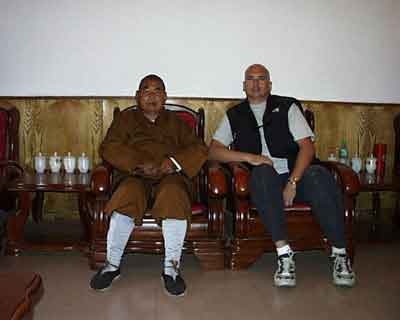
Shi Su Xi and doc
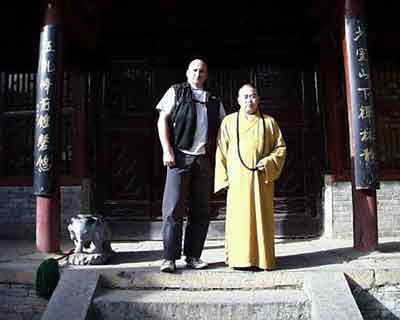
Shi Yong Xin and doc
The last of the four, Shi Wan Heng, is eighty years old. He is one of my master's (She De Cheng) masters, and he is the one who taught most of the gong fu to the monks. He still practices gong fu every day, and from looking at the way he walks, I believe it. An extremely friendly man, he invited me into his "home", a single room, with a temple room next door. We talked for almost an hour via a translator. It was he who invited me to the so called "inner sanctum", the Buddhist prayer meeting held twice daily at one of the temples in the Shaolin Temple.
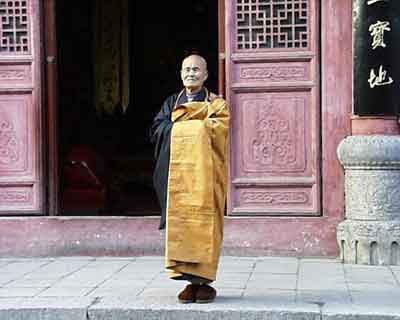
Shi Wan Heng
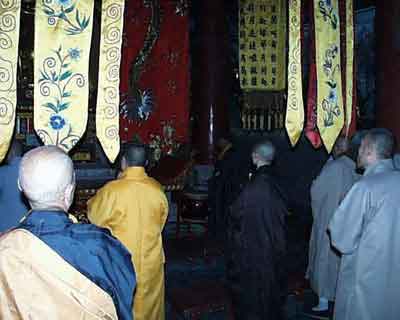
AM prayer ceremony
They hold these prayer services twice a day, once at 5AM, the other at 5PM. Thank god I wasn't invited to the early edition. The service took about twenty minutes, and was full of singing and chanting (far better than the shit I hear every night from the karaoke bar), drum beating and bell ringing. Very impressive. I even got pictures, some of which are in the Sanctum file. After services, the big master She Wan Heng, his disciple (another master She Su Gong), and I went to dinner at one of their favorite hole in the wall places. I have a picture of the kitchen, but I can't remember if I included it in the file. That kitchen was a story all in itself. They enjoyed their dinners, and I "enjoyed" my greasy fried rice. I longed for a fake chocolate protein drink. And yes, they ate meat. "I eat it when I can get it", Shi Wan Heng told me. "What are you going to make of it", is what he was probably thinking. So much for Americanized attitudes towards Shaolin Temple monks.
It was an interesting afternoon. I made a few friends, some of which want to come to the US for a visit. Just what I need, a few old masters wandering around the house. I can see the dogs now. We exchanged addresses, and I was off. I had promised fluffy cloud that I would visit her English class which she held at 7 PM every night for the students.
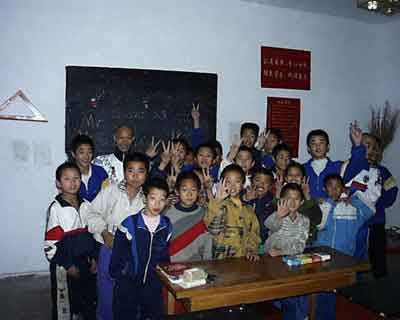
When I got there at 710, all of the kids got up and cheered. As if they've never seen an American before. I gave a nice short speech, which no one understood, using my best New York accent, and then sat in this little little chair next to this very little little boy. I sat through a very painful hour of class, as the only lights were these bare bulb fluorescent lights, which are basically anathema to me. But it was fun. Fluffy cloud would come back to me an ask me if she were pronouncing the English words correctly; not to embarrass her in front of her class, I always told her that her English was perfect. I also did not want to try to teach her the correct way of pronouncing "L's" and "R's". The class enjoyed having me there, and then wanted me to do some gong fu poses with them after class. Gong fu rules here, English and math (they only learn very basic mathematical skills, I surmised from looking through their "textbook", basically a pamphlet). After class, from 8 to 9PM, instead of going to their beds and resting, they were all out on the steps of the wushu guan, practicing gong fu in the moonlight, and kicking a large hanging sandbag. The bigger kids were smacking this thing with their feet, not causing it to move much as it was a heavy canvas bag full of a lot of dirt (heavier than most of the students), but making a lot of noise, as they hit it with power. Of course, they wouldn't let me go until they saw me kick it. I did, causing the bag to swing wildly, to everyone's amazement, especially mine. Big baldy killed the bag. Everyone cheered, and I had been accepted. I have many new friends, all of whom I can't remember their names, and couldn't pronounce them if I could. No matter, I can't tell them apart anyway.
Oh, and here is picture from the Pagoda forest. Those stone structures are burial grounds for the famous monks. There are 284 of them, dating in age from 1996, when the last one was built, to over 1500 years ago. I fear that number 285 is going to be built real soon....(see gallery below)

Pagoda Forest: Shi Zheng Xu Pagoda
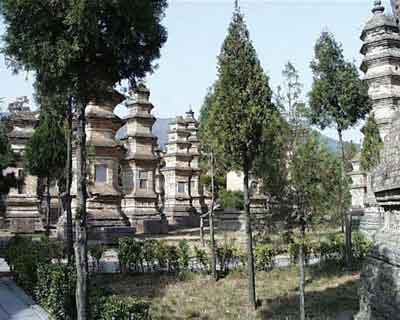
Schooling at the Shaolin Temple Wushu Guan, 1998
The school day starts at 0500, at which time all the students get up and run anywhere from a kilometer or two. After that, upon their return, they wash their hands and faces and eat breakfast at around 0700. Breakfast consists of a steamed bread like bun, and rice, usually in some sort of watery soup like mix. At 0830, gong fu training starts. The typical gong fu training starts out again with some running, usually up and down some stairs, and in the immediate area. That lasts for about ten minutes or so. They usually run in a team, lined up in pairs. After that there is a cool down period, where a game is played. It appears to me to be some sort of tag game, as they all stand in a large circle (each class has around twenty students), and two of them run after each other. It all appears friendly enough, as they chase each other in and around the circled students, but occasionally, it is not unlikely to find the somewhat unpleasant noogie being offered to the unfortunately caught recipient. It does become a bit unorderly in a fashion, kind of reminded me of recess in grammar school. Structure reappears when stretching begins.
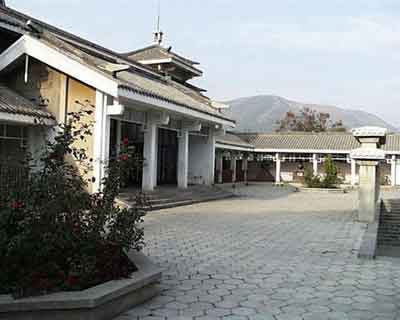
Wushu Guan
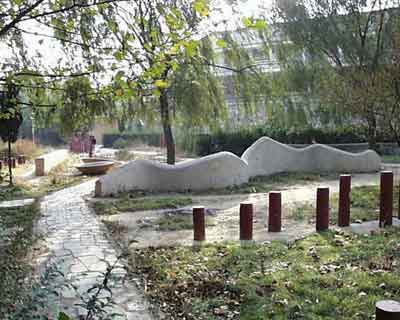
Training area
Stretching is done on their own, usually by putting their legs up against a wall, or doing splits with one leg on a stair, to over extend their split. They don’t generally do anything too extravagant when it comes to stretching. Some help others by pushing their legs up over their heads. It is not an organized procedure, each does what each feels is best for himself. Stretching then "continues" with kick practice.
They line up in two rows, walking behind one another, practicing the same thing, one after another. Usually the two rows move in unison, stepping forth and kicking as one. Initially, kicks are done softly, to warm up, first a high instep kick straight up over the head, next, a high instep kick across the body to the opposite shoulder. Then crescent and reverse crescent kicks are done. This whole procedure is repeated in a more formal way, with the arms extended horizontally, fingertips up. This is supposed to aid in balance improvement. Finally, a kick that extends to the side and up over the head is performed.
After this, basic gong fu maneuvers are done, usually the same ones every day. I assume that the instructor changes these as time goes by, but essentially, they do a good deal of the 18 of them. This whole process usually takes about an hour, at which time a ten minute rest period is prescribed. Somewhat after 1000, the students get back into their rows, but this time prepared with weapons. Form training is about to begin.
They might do a small segment of a form, such as part of Xiaohung Chuan, or they might do part of a weapons form. It appears that each student has a form or weapon of choice that he becomes perfect in. But there is evidence that cross training goes on. By 1100, class is over, and the students retreat to their rooms, for rest, and preparation for lunch.
Noon brings a typical meal of rice and vegetables, to which this day I can still not identify, and usually a small amount of pork. Meals are cooked on the premises. After lunch, a rest period occurs (called sushi ya), and class then reconvenes at either 1430 or 1500.
The students are basically split at this point, based upon age. The students range in age from 10 to their early 20’s. I should probably digress here. Most children in China go to basic school, starting at age 7. They learn basically what we learn in America, with the exception that the history and language is that of China. It is safe to say that a majority of them continue on through basic school, learning music, history, literature, Chinese and mathematics, to the end of basic schooling, which occurs at age 18. A small percentage, maybe about 10%, then are successful enough to gain entrance to college, which lasts 3 years, and costs around 3000 Yuan an year. Interestingly enough, the main course of study in college is English. Graduation occurs at age 22, and the graduate then enters the workforce somewhere. Not all Chinese finish basic school, some leave and enter the trades, or work the fields.
A few desire to learn gong fu, with the ultimate goal of becoming a policeman, bodyguard (used to be popular to be a bodyguard in Hong Kong, now that the Chinese own it again, and one would assume, "crime" is better taken care of, I don’t know what the needs are for this now), gong fu teacher, or, those with really high hopes, TV or movie star. Some want to be able to perform gong fu, seeing this as a ticket to another country eventually. A few of these students in the Shaolin School opt to become monks. The best that become monks end up doing the gong fu performances.
So, when a child the age of 10 or 12 leaves basic school to learn gong fu, he goes on the above path, leaving behind training in history, geography, and all the other usual scholastic stuff that we all learned and loved. Instead, his mornings are used for gong fu. However, his afternoons are oriented towards scholastics. Class starts at 1430, for three hours, with ten-minute breaks each hour. Three subjects are taught, Chinese, English, and mathematics. Class for these children ends at 1730, at which time they prepare for dinner, which occurs at 1800. Dinner by the way, is the usual rice, mystery vegetables, pork, steamed buns and noodles. After dinner, the student’s time is their own; some practice gong fu, others walk through the village and visit friends. All are in bed by 2130 after a quick warm shower and clean up.
The older students, who are presumably better versed in Chinese than the others, have gong fu practice which starts at around 1500. The class is the same as the morning one. It ends at 1700, after which preparation for dinner occurs. Some of these students then go to a 1900 one hour class in English, others practice gong fu, others just cruise around visiting people or rest. All take warm water showers at night, and are in bed by 2130.
The usual fee for Shaolin gong fu training is 3000 Yuan a year, it includes lodging (if you can call this lodging), food (if you can call this food), training, classes, and school clothing, usually something that says Nike or Adidas on it, with a poorly applied white lettering on the back, which identifies the school. Clothing has changed in quality over the last four years; while years ago one saw more of the traditional garments on the children, now, more children wear better quality sweat suits. The usual old style Keds sneaker (the Chinese variety) is being replaced now with a more modern looking running shoe. It is obvious in all aspects of Chinese life that western wear and attitudes are starting to pervade. Remember, the Shaolin school is considered a "public" school, as the Temple and the wushu quan are "owned by everybody", i.e., the government.
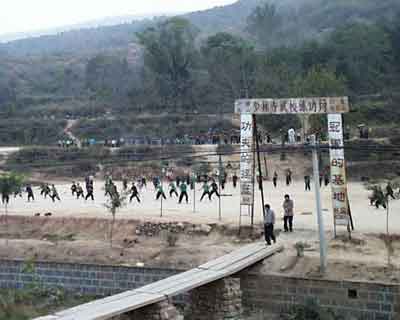
Surrounding the Temple are dozens of private schools, some of which are taught by previous monks, some taught by lay man well versed in gong fu, some not so well versed in gong fu. I guess that if you have the money to build a school, and you can get people to come train with you, you can open a school. From what I can tell, most of the gong fu taught in the private schools is very similar, if not the same, as the gong fu taught in the Shaolin Wushu Guan. Of course one would expect individualization, from one instructor to the next, as he alters what he teaches to suit his own needs (as I seem to find in the US all the time), but this is not the norm. Xiao Hong Chuan at one place is Xiao Hong chuan at another. All of the 18 basic weapons are taught, but predominantly, the Chinese broadsword, the bow staff, chain whip, and spear are the most common. Of course, the 18th weapon, the hands, are taught everywhere. At the Shaolin Wushu Guan, all the remaining weapons are taught, a process which basically passes on the information and the legend to newer generations.
There are about 180 different gong fu forms, comprising the 18 weapons, and more animal types than you can imagine. The forms not only include the usual lions and tigers and bears ("Oh my!"), but also include praying mantis, snake, eagle, monkey, drunken man, crane, frog (yes, the frog; that is one that you should see before you die), and many others, more than I ever encountered in my karate practice in the US. My master, She DeCheng, knows around 80 of these. And when I say know, I mean, be able to perform perfectly (I know five, and when I say know, I mean make abortions of). Other masters know some similar, and other different ones. It is in this way, by passing on the knowledge of these forms to multiples of people, that the tradition is passed on and kept.
Other points of interest…. The emperor, being the highest of all, was the only one who could use the number nine in many ways (the doorways at the Forbidden City Imperial Palace are cut in a fashion that their dimensions are in multiples of nine). The emperor got the highest number. Nine is the highest because the Chinese count from 0 to 9, as opposed to us, who count from 1 to 10. The monks I assume then got the next highest number, 8. This is probably the reason why gong fu has so many groups of forms in it that are in multiples of 8, or has the number 8 in it. Baduajuin qi gong has 8 steps, Lohan Drangoon qi gong has 32 (though for some reason I know 33 steps), and many of the forms have either around 64 or 108 steps, depending upon how you count the steps. There are 18 basic gong fu maneuvers, which are the derivatives of the 18 hands of Lohan, the original training exercises given down over the ages.
A bus ride....
But let me tell you about my bus ride tonight, as I returned from DeQing’s private gung fu school. The buses here are about half the size of our buses in the states, and like some of our buses, they are packed full of people. But the bus drivers over here do not have the luxury of having those little steel bars around them, which essentially put them into protective cages. Here, at least in the boonies, people sit with the bus driver. Count them, four. One guy was almost in his lap. There is a woman who stands in the center of the bus, right next to the only door, who collects cash; one Yuan. I had to squeeze into this thing, both in the horizontal sense and in the vertical. People are not in the habit of moving out of the way to let you get on or off, you essentially have to slither around them. And if the ceiling of the bus were about three inches lower, my shoulders would have touched it. Compound that with the fact that a good deal of these people do not use hot water to bathe (compound it with the fact that I didn’t use hot water to bathe today), and some people smoke these absolutely disgusting cigarettes, which I gather are made of old newspaper, some sort of tobacco, and rat shit, and you have one hell of a ride. Everybody was very amused at how well I moved through the thoroughly packed bus, and how with every slightest bump in the road, I would bang the back of my head. The top of my head was usually aimed towards the front of the bus, where four people shared a seat with the bus driver.
Traveling on the roads out here is definitely an experience. There are no streetlights. Well, there is one in Deng Fen, but it doesn’t work all the time. There are no overhead lights; the only lights on the road are the ones on the cars, and half of them either don’t work or aren’t turned on. I guess they kind of navigate like bats do at night, they honk their horns, and if they don’t hear a honk back, there’s no one ahead of them. Right of way is a term which basically doesn’t exist. Basically, if there is no one in front of you, you can go there. If two of you want to go into the same space, trucks win, bicycles lose, and if it’s a draw, whoever honks the loudest, or gets there first, gets the space. If your driving a one cylinder tractor with a whole bunch of shit on it, you just pretend that you don’t know of anyone else on the road, and you just keep driving. Very slowly. And in the middle of the road. You have to give the Chinese credit for not passing on the right; they only pass on the left. And if you’re on a four-lane road, traffic stays in the middle lanes, keeping the right hand lanes clear. Why? Basically, bicycles and people are there, and the occasional family camping out, and it’s bad form to run people over. Which leads me to the concept of liability. It’s actually pretty simple. Out here in the boonies, if you hit someone, it’s your fault. You pay the other guy money to get his car fixed, or to bury his mother, and you’re on your way. If you can’t pay, and a cop can be found, you can go to prison. Insurance? Not out here. They don’t use it. (I hear that it is government run in Beijing). I guess they all found out about my luck with insurance companies, and decided that it was a waste of time. Actually, an insurance company is forming out here, and motor vehicle insurance is going to be an existing entity. And with insurance companies will come lawyers. Personal injury lawyers. God help them. They know not what they do.
After spending a nice afternoon with white cloud (I can’t remember her name, but she is the English and mathematics teacher at the Wushu Guan who would come up every afternoon on her break and watch me work out, as if that’s entertainment. I just call her white cloud, she calls me Mr. Richard. Very cute. I told her she could call me by my Chinese name, which is She Shin Hung, or just Shin Hung. I asked her what my name meant, and she told me "very big". (HA!!!). She was the source of some of the above information, which I was looking for in order to do a "project" when I got back home. I also used her to order real food for me at the only restaurant that I know of in town that has semi-identifiable food. I had completely given up on the idea of going to this place with my little electronic translator, and type in "pork", "red sauce", "veggies"; the last time I did that at a different restaurant I got a plate of cooked pig’s blood, with a side of semi-cooked slices of pig’s fat. Very appetizing. Not exactly as easy as in Beijing, where you walk into a McDonalds and point at a picture. The biggest problem in McDonalds is trying to get those little packets of ketchup. Reminds me of the time years ago when I walked into a Pizza Hut after three weeks training in Shaolin, ordered a pizza with extra sauce ("More red stuff!"), and they gave me a pizza with ketchup on it. They were very amused. They thought I was pretty weird. Screw them. I ate it.
DeQing's school, or why I'm glad I went into medicine...
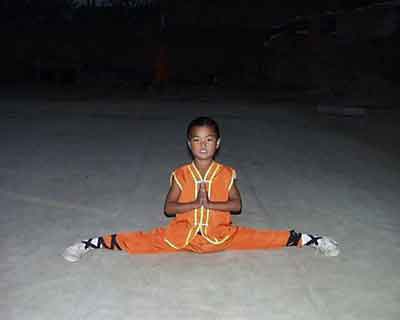
Well, here are some shots of my "stand in" master, De Qing's private school. He teaches for the Temple, but at night, he goes to nearby Deng Fen to oversee the instruction of children in his own private school. Over here, school is not very common in the rural areas. A small amount of children get the opportunity to go to school. Some end up in gong fu schools, most of which are run by monks that have left the Shaolin Temple. Some schools are taught by non-monks. The typical school has anywhere from twenty to thousands of children. Wake up is typically at 0530, at which time running, into the mountains, or down the street, is done. After that, breakfast, usually a rice water mix and some fried bread things, is eaten. Training for about two hours in the morning, followed by two to three hours in the afternoon, and sometimes another two hours at night in the summer, with Chinese language, and occasionally English language classroom training interspersed in there. Dinner is usually comprised of rice and or noodle something or other, as is lunch. Wash up occurs at night, and everyone is in bed by 9 PM. It is not uncommon to fit ten to twenty students in bunk beds, all put together, in a small single room, with one bare light bulb hanging from the ceiling. Bathroom facilities generally consist of a pit over which concrete slabs, with spaces between, are laid. It is not an easy life by any means. The martial arts skills of these children however, is simply amazing. The nutritional status is another issue.
Where was I? The evening was spent at DeQing’s private school in Deng Fen. I was there also to get information for the same "project", part of which was an inquiry into gong fu training in China. De Qing opened his own school in December of 1997, and it has steadily grown in numbers to 45 students over the year. They range in age from a young, and very adorable 9, to the early twenties. Most kids are here because they want to learn gong fu, some are here because their parents sent them here. Imagine that, being 9 years old, and knowing what you want to do with your life. I’m 41, and I still don’t have the slightest idea what I’m going to do with my life. Their parents pay 6000 Yuan a year, this includes all food, clothing, supplies, lodging, and training. Pay 6000 Yuan, drop the kids off, and don’t see them for a year. Yes, that is basically what happens. Some parents visit every two months or so, some don’t visit for over a year. These kids are basically from well to do families (don’t ask me what "well to do" means in China. Maybe, we didn’t have to eat our dog last year….). 6000 Yuan is actually a lot of money, as white cloud only makes 5000 Yuan a year as a teacher, and the monks make around 500 Yuan a month being monks. Or was that a year? I can’t remember. If I remember, I’ll ask again.

Their typical day is a little different from Shaolin. They wake up at 0520, and are expected to be up and ready to run by 0530. They run three to four kilometers in Deng Fen regardless of the weather, and are back by 0640. Breakfast, the usual steamed bun thingies, watery rice soup, and the like (no Egg McMuffins here), is at 0700. The morning workout starts at 0800; it includes the usual, some running to warm up, stretching, kicking, jumping, basic gong fu, and forms. There is a ten minute break, and class ends at 1100. Class is run somewhat in the format of "me drill instructor, you piece of shit", with coaches barking out orders to these poor kids, and the kids instantly and attentively responding. It’s just like the military, though, I haven’t been in the military, from what I’ve seen in the movies, this is it.
Lunch is at 1120, and the students are expected to finish by 1140. There is a rest period from 1140 to 1440, during which the kids can sleep, practice gong fu, or just hang out. At 1440, they start assembling for workout which starts promptly at 1500. The usual routine is again gone through, with the usual ten minute break, and it ends at 1740. They have twenty minutes to clean up and get their bowls and chopsticks, and at 1800 they line up at the kitchen in a very orderly fashion to have the slop handed out. Dinner tonight was rice with some sort of fried vegetable mess, and they are allowed to eat all that they want. I opted out of dinner, deciding instead to go back to my room and have one of those delicious fake chocolate protein drinks mixed with water most likely bottled out of the river. Dinner ends promptly at 1830, which is followed by a short rest period. At 1900, training starts again, but this time only for an hour. At 2000 they have to wash, and at 2030 all are in bed with the lights out. Washing is an experience, as is the toilet. First, washing. There is a bowl, actually, each student gets one. A round plastic thing that you fill with cold water from the tap, that you wash with. Sometimes, the kitchen will warm some water up, so that the kids can wash with warm water. If you want a shower, you take the bowl of water and dump it over your head. I found the whole thing interesting, as for some reason, I smelled and the kids didn’t. I guess I have to find one of those bowls.
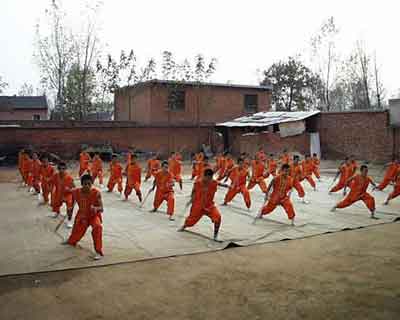
As for the toilet, there isn’t a bowl. (Oh, by the way, that's the toilet in the far back corner). The Chinese build everything out of brick, and these concrete slabs. The concrete slabs are preformed, in different lengths, all about a foot and a half wide, with tubular holes inside them to cut down on the weight. They use these for flooring, steps, roofs, everything where you need some sort of platform. Two by fours and plywood don’t exist. It’s just brick, concrete slabs, and cement to stucco smooth. When they need to board something up, whether it be a window or a hole in a wall, they just stack bricks. Well, anyway, the toilet is basically a large pit over which lie these concrete slabs, oriented in such a way that two lie parallel and separated, and one lies across, as in a large T. You squat on top of the cross one, with the ultimate hope if hitting the spot between the two parallel ones, and with the very ultimate hope that you don’t lose your balance. The students liked everything about the school, but they weren’t too happy about the bathroom. I made sure I didn’t have to go before I went to DeQing’s school; I saw it last trip.
Now there’s more to life than gong fu, and in DeQing’s school, they just got a teacher. The teacher teaches during training sessions, but the students alternate. The young kids might go one morning and the next day afternoon, rotating in that fashion, and learning Chinese and mathematics, while the older kids might go in the afternoon that day and the morning next, while learning English. While one section is in the school at class, the other section is out in the yard practicing gong fu. There doesn’t seem to be any reason in these gong fu schools to learn anything but Chinese, English, and mathematics.
They basically do this six days a week, with Monday off. Sunday afternoon is also off. The students spend their day and a half off doing what the head coach wants to do (the head coach, as are the two other instructors, DeQing’ old students). One weekend might be spent renting and watching videos on the one TV and VCR, or they might walk around DengFeng, play ball, sing, or they might hike up a nearby mountain. Regardless of what they do, they do it together. There is little sense of individualism. Sunday mornings are also very special, because the entire class does a ten to fifteen kilometer run that morning, at 0530, regardless of the weather. Monday, there is no running. It’s a day off. They get to do whatever they want, as long as the head coach wants to do it, and they all do it together.
From a big ugly (and bald) American’s point of view, it is really a shitty existence. I could never fathom American children doing this. Most plan on doing it for three to five years. One would think that there is a reason to put oneself through all of this, much like one puts oneself through a bunch of shit to become something, like a doctor. These kids are here to learn gong fu. Do they have any desires to become policeman, something a little goal oriented? Of the kids that I asked, one wanted to join the military later in life, two wanted to be coaches of gong fu, and all the rest just wanted to learn gong fu. Why? What is it about this that makes these kids travel a thousand kilometers (almost all of the students are from DeQing’s hometown)? It’s a cultural thing. All children grow up idolizing the Shaolin Temple monks. Only the best become the gong fu monks. There are no sports heroes here, no political figures to idolize, nothing but the sacred tradition of the Shaolin Temple. And the Shaolin Temple symbolizes gung fu. It’s almost like baseball and American kids, or basketball. We have our Michael Jordan's and the such, the kids here have their DeQing (and me! "He big and strong, want to be like him" Not eating the shit you eat kid...). When a monk opens his own school, it is besieged by the children of his home town, as that monk, basically, has become that town’s hero. No wonder why DeQing, who wants to come to America, does not want to leave or lose his school. I can see the worship in the children’s eyes when he stands at the head of the class, almost like the worship in my dog’s eyes, when I dangle a milk bone in front of them.
They all want to be movie stars. But they are all realistic in knowing that they won’t be that. But interestingly enough, most of them have no goals, other than learning gong fu. It kind of matches the ideals that I have noticed in most people here. They really do not work on any sort of time schedule (DeQing’s school, with it’s punctuality, really struck me as abnormal here); people do what they need to do to survive, and they do it as they can. It is not exactly a stressful environment as the one that we create in the US. It appears to me that these people, with their relative lack of health care, their poor diets, and their unsanitary living conditions, for some reason appear healthier than their US counterparts. There is more of a "live for today" motive than "setting goals for tomorrow", a "I'll get it done when I get it done" attitude, an attitude which is best exemplified by it’s young.
And for today's lesson in heating rooms, did you know that a well placed laptop, positioned under the covers while playing a computer game, offers an incredible amount of warmth?
One hell of a dinner....
One week to go, and hopefully I'll be off to Tibet for a few days. It is only two hours by air from here, but administratively, it has been a bit of a headache getting it arranged. It has been a trip that I've wanted to do for a very long time.
Enclosed is a photo album slide show that I took last week, before the weather turned shitty. It will give you an idea of what the Shaolin Village looks like, the training center, and the surrounding mountains. It is a land of extremes, as is all of China, from incredible poverty to the rare Mercedes Benz, indoor restaurants to "outdoor restaurants", and just plain scary "restaurants", comfort to survival. You can see very typical Chinese culture, and also see western influence (the "prostitute" was a late arrival to a dinner that I went to with She De Qing and his friends. She was for his friends. We left before anything "unmonklike" occurred). The dinner was quite the event, during which I had the very lovely experience of eating pigeon. Great legs. Yumm. I highly recommend it. The fish was good too. They bring this poor unfortunate fish out to your table, let it flop around the table to show that it is alive, and then cook it. They bring it back, looking much as it did when it was alive. Not cleaned, skinned, or gutted. Then you pick at it. If the head points to you, you get to eat the eyes. I slowly turned the Chinese serving table to ensure that it wouldn't be looking at me. Not bad. It does get a little disgusting when one of the Chinese picks up the head and chews on it. They seem to like chewing on pigeon heads too. It was offered to me, but I politely turned it down, and headed back towards the rice. There's a limit as to how much culture I want to assimilate. And rice wine. God that stuff is awful. Everybody is always toasting something. And with every toast, you get to pick up this damn little cup, the size of a thimble, and slug down this tablespoon of rice wine, which the servant girls always try to keep full. Two slugs and I was starting to feel it. So, when it came time to toast, like, every five minutes, I'd put the little little glass up to my lips, and press it tight against them, so that the rice wine stayed in the cup. This fooled everybody, including the poor little servant girl, who, after a while, could not figure out how I was getting my little cup filled all the time. It was an event. It was also the only "real" food I had in the past two weeks.
I cut training short yesterday, and cancelled it today, as I try to do battle with a very stubborn bronchitis/URI. Many of us are ill, as the weather changed for the worse quite drastically a few days ago. The lack of heat in the rooms, and the rare hot water, now that the Buddhist "holidays" are over, (the tourists left, so they don't heat the water just for me), make it all the more difficult to get better. The monks are treating their illnesses with medicinal herbs, I, with antibiotics. They're getting better, and are working out again. I'm in bed. I'm not sure what to make of that. In any event, it is not slowing me down all that much, as yesterday, De Qing got me into the Shaolin Temple for what was a very major event. Some sort of big Buddhist religious thing, something along the lines of "invitation only", from what I could gather. It was a very formal event, into which much preparation had occurred. The Temple was spotless, as I've never seen it before. And, all of the reconstruction was done, in a manner similar to construction from centuries ago.
Click to open:
OK, got to go. Time to pour some hot water on some freeze dried noodles and beef. Hope you enjoy the pictures.

